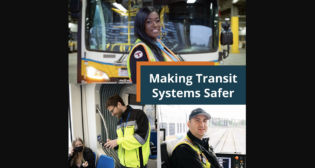
The U.S. a leader in LRT? Believe it
Written by William C. Vantuono, Editor-in-Chief
Take a wild guess: Since the turn of the century, what nation has opened more new light rail and streetcar systems than any other on earth? Germany? Nein. Italy? No. China? 否. France? Non. Russia? Нет. Japan? いいえ. IThe Netherlands? Nr. It’s actually (drumroll please) . . . . . the United States of America.
Yes, you read that right: The nation that tore up most of its interurban and streetcar systems when (conspiracy theorists and many “trolley jollys” claim) General Motors began buying them up, tearing them up and replacing steel-wheeled vehicles with its rubber-tired diesel buses, has since the Millenium built more LRT and streetcar systems—23—than even France, which has built (no doubt influenced by Alstom) a mere vingt (20).
Mull over that as you munch on your pommes frites (Freedom Fries) at your local burger joint. Viva Les Etats-Unis!
But don’t take my word for it. Figures, except if you’re the Congressional Budget Office, don’t lie. The UITP (International Association of Public Transport) has issued a new report, “Light Rail in Figures,” showing that, since 2000, more new LRT and streetcar systems have been opened in the U.S. than in any other nation.
“Significant growth in LRT and streetcars in recent years has seen the creation of 78 new systems internationally since 2000, with the U.S. and France leading the way with 23 and 20 respectively,” the report states. “LRT and streetcar (UITP calls these “tramways”) systems are in operation in 388 cities around the world, most of which are in Europe (206) and Eurasia (93). They carry some 13.6 billion passengers per year, with the ranking of busiest networks in passenger numbers headed by Budapest (396 million), Vienna (363 million) and Bucharest (322 million). There is a current total of 15,600 km (9,672 miles) of track globally. Melbourne (245 km, 152 miles) and St. Petersburg (240 km, 149 miles) boast the world’s longest networks.”
You can look at these numbers and, depending upon whether you are a pessimist or an optimist, say that the glass is half-empty, or half-full. If you’re a cynic, you can say that the U.S. is simply playing catch-up, and will never surpass the rest of the world, in terms of total number of systems and ridership. Well, back in the early 1960s, some were saying the same kind of thing about NASA, but it was Neil Armstrong, not Alexi Leonev, who first set foot on the moon.
If you’re from the Reason Foundation or the Cato Institute or the Tea Party or the The National Asphalt Pavement Association, you will most definitely say that all 23 systems built in the U.S. since 2000 have been an unconscionable waste of public tax dollars. To those people, I say, collez-le où le soleil ne brille pas!
 The UITP, which now has a U.S. office in New York City, released its report at the International Rail Conference in Munich, “which brought together the global rail industry to discuss the challenges facing it and share some of the potential smart solutions for energy, safety, maintenance and more.” UITP and the event participants issued together the Munich Declaration “highlighting the importance of rail to cities, calling on policymakers to keep a focus on urban rail and encouraging planners to review conventional design practices to keep costs under control.”
The UITP, which now has a U.S. office in New York City, released its report at the International Rail Conference in Munich, “which brought together the global rail industry to discuss the challenges facing it and share some of the potential smart solutions for energy, safety, maintenance and more.” UITP and the event participants issued together the Munich Declaration “highlighting the importance of rail to cities, calling on policymakers to keep a focus on urban rail and encouraging planners to review conventional design practices to keep costs under control.”
“Local rail, including trams, metros and commuter railways, provides safe, convenient, affordable and sustainable mobility to 265 million people in some 400 cities around the world every day,” said UITP Secretary General Alain Flausch. “As a result of its attractiveness, many urban rail systems face overcrowding. Significant investment is required to meet this growing demand: more lines, extensions, additional rolling stock and improved signaling but also to maintain and refurbish systems sometimes built more than a century ago.”
Want to learn more about LRT? You will want to obtain a new publication from Simmons-Boardman Books: Elements of Planning, Engineering & Operating Light Rail, With Applications in New Jersey, by Railway Age Contributing Editor Al Fazio (yours truly is co-author). You will also want to attend a new LRT technical conference presented jointly by Railway Age and Railway Track & Structures. It’s scheduled for April 27-28 in Philadelphia. If you’re a Professional Engineer, you’ll be able to earn PDH (Professional Development Hour) credits at this event. Click HERE for details.



